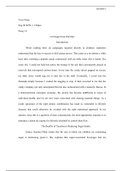Essay
ENG98 M/W Essay 1: Cut Sugar from Our Diet
- Course
- BUS/MKTG (ENG98M/W)
- Institution
- Thompson River University (TRU )
Introduction While crafting their ad campaigns targeted directly at children, marketers understand that the key to success is kid's pester power. This came as a revelation a while back after watching a popular candy commercial with my baby sister who is barely five years old. I could not help but...
[Show more]



